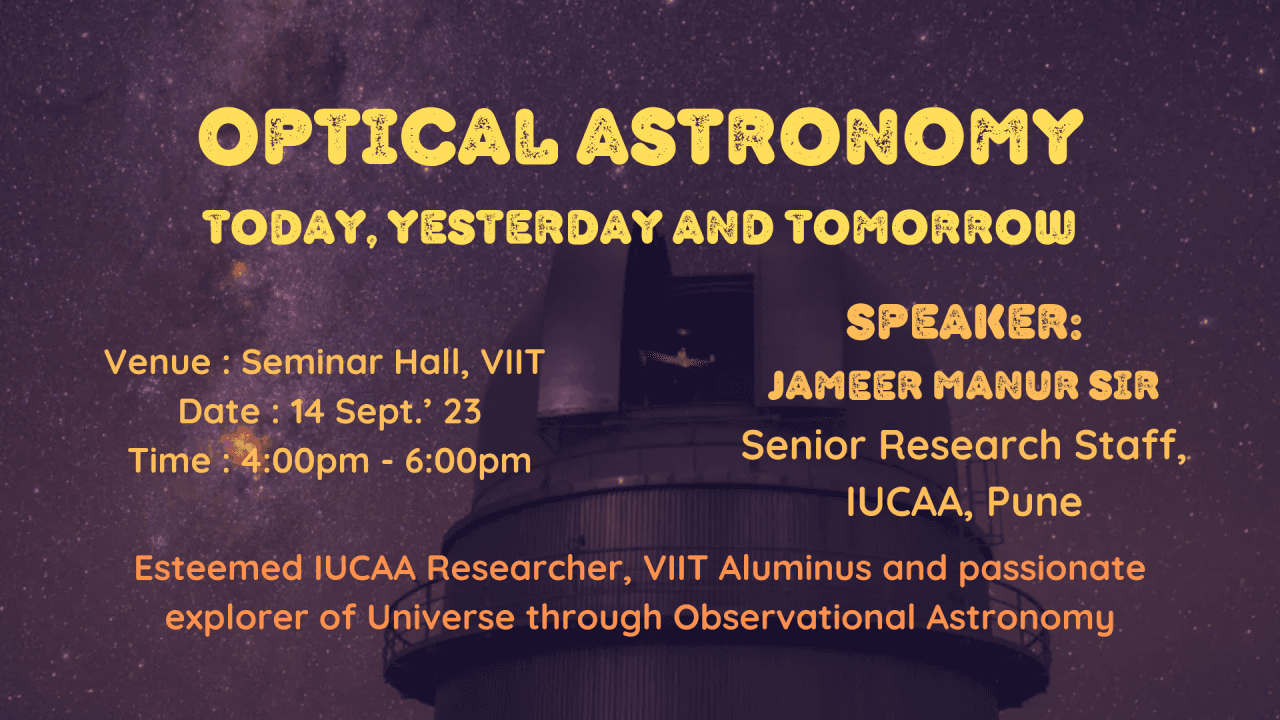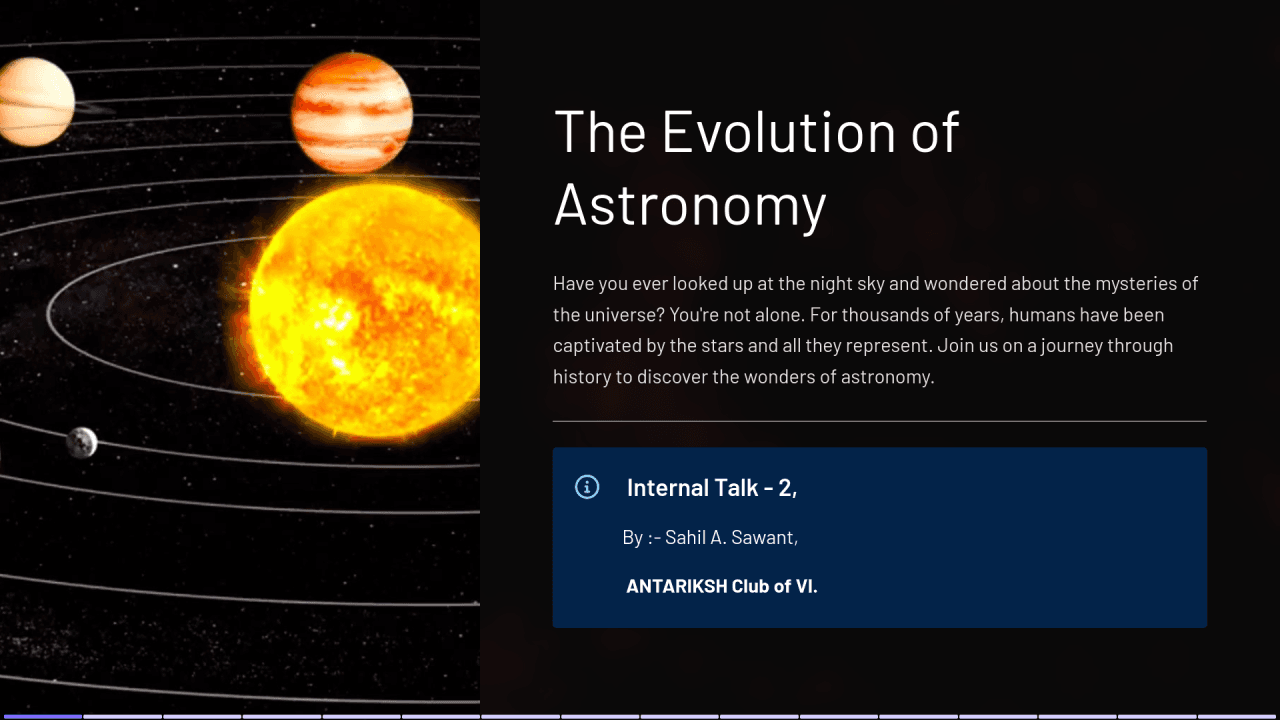The Antariksh - Astronomy Club of Vishwakarma Institutes organized an enriching Astrophotography workshop on November 4th, 2023, in room C-301 in the Vishwakarma Institute of Information Technology (VIIT). The workshop was conducted by the distinguished Mr. Jameer Manur , the founder of the Antariksh Club and a Senior Research Staff member at the IUCAA, Pune, India (Inter University Centre for Astronomy and Astrophysics). The event was divided into three sessions, each offering a unique perspective on the fascinating world of astrophotography.

Session 1: Introduction to Astronomy and Fundamentals
The workshop began with the introduction of Mr. Jameer Manur to the audience. He initiated the first session with an interactive discussion on astronomy, asking the students what came to mind when they thought about astronomy. The audience responded with planets, galaxies, and more. Sir emphasized that astrophotography is a blend of skill and art, encouraging the participants to learn the basics and apply them creatively.
Mr. Jameer Manur explained the challenges of capturing images on the horizon due to air turbulence and varying temperatures in different layers. He also shared an interesting insight that stars appear to twinkle due to atmospheric disturbances. To illustrate key concepts, he presented an image of the Sun with sunspots and discussed various features. He delved into solar eclipses, covering annular, partial, and total solar eclipses, sparking the curiosity of the students.
The session continued with a discussion about celestial objects visible in the night sky, including stars, the moon, nebulae, galaxies, and star clusters. Sir touched on Earth's motions, including rotation, revolution, and precession and also mentioned the historical significance of Thuban as the pole star in ancient Egypt. The sides of the pyramid aligned using the thuban star.
Mr. Jameer Manur also introduced the concept of solar and sidereal days, explaining Earth's tilt, equinoxes, the celestial sphere, and solstices. He detailed various astronomical coordinate systems, such as the local coordinate system (latitude and longitude), celestial coordinate system (altitude and azimuth), and universal coordinate system (Right Ascension and Declination). To engage the audience, he presented an image and challenged them to extract information, including exposure time, altitude, direction, and whether it was sunrise or sunset.
The session concluded with an awe-inspiring display of astrophotographs captured by Sir. Further he talked about the Laniakea supercluster and the Great Attractor. He shared that only five superclusters have been discovered to date, including the Saraswati supercluster from his own lab.
Session 2: Astrophotography Fundamentals
Following a 30-minute break, the second session commenced. Mr. Jameer Manur discussed the fundamental concepts of astrophotography. He explored factors influencing astrophotography, including Earth's motion, the rotation of the night sky, the brightness of celestial objects, and the choice of instruments.
Sir introduced the concept of magnitude as a measure of celestial object brightness, where negative magnitudes indicate brighter objects and positive magnitudes indicate fainter ones. He also emphasized that approximately 5100 stars are visible to us.
Instruments used in astrophotography were discussed, including telescopes, image sensors, and filters. Sir touched on Galilean and Newtonian telescopes and explained the shift from lenses to mirrors in telescopes due to chromatic aberration.
Mr. Jameer Manur provided insights into the human eye as our most important telescope. He discussed the eye's size, shutter speed in milliseconds, and its dynamic range, ranging from 6 to -26 in magnitude. The presentation covered photographic plates, CCD and CMOS sensors, and color camera Bayer masks.
The audience was educated on ISO, noise, shutter speed, and aperture settings in astrophotography. Sir explained the relationship between ISO and lighting conditions, emphasizing that high ISO is suitable for low light, whereas low ISO is preferable in bright conditions. He told us that insufficient light and high ISO leads to noise creation. Also, Shutter speed(the speed at which the shutter of the camera closes) was determined using the formula 500/f (f being the focal length of the device), and aperture size was discussed in relation to the brightness of the subject.
He introduced CCD cameras, known for their quantum efficiency, enabling the capture of even a single photon. He also discussed the features of DSLR cameras and the use of remotes to minimize camera shake.
Factors affecting image quality were explained, including magnification, observing conditions, aperture size, optical quality of the telescope, CCD resolution, sensitivity, and noise.
The session concluded with a discussion on planning for outdoor astrophotography, covering location selection, target objects, weather conditions, instrument limitations, and the importance of having a backup plan.
Session 3: Hands-On Experience and Conclusion
After a 15-minute break, the third session began with Mr. Jameer Manur showcased his personal astrophotography kit, which included a DSLR camera, tripod stand, aperture control lenses, solar filter, red torch, various filters, and an intervalometer remote.
In this practical session, the audience had hands-on experience with image stacking using the software DeepSkyStacker. The images were then enhanced using Adobe Lightroom, with students following Sir's instructions on their respective laptops.



Conclusion:
The astrophotography workshop led by Mr. Jameer Manur who was accompanied by Mr. Anant Sir was a remarkable journey into the world of celestial photography. Thanks to the dedicated efforts of the event heads [ Kaushik Salunke, Chinmay Dalvi ], core committee members [ Anas Ansari, HARSH JALNEKAR, Sahil (Samael) Sawant, Chanchal Rathad, Rajan Sudan, Gyanesh Choudhary, Aditya Bhoite, Bhavya Shah, Gautam Kulkarni, Sumit Chandanshive, SIDDHANT GHODKE, Shreyas Gaikwad, Shreya Channawar ] and all the volunteers from the Antariksh - Astronomy Club , the workshop was a resounding success. Participants had the privilege to learn from Mr. Jameer Manur, gaining valuable insights and hands-on experience in astrophotography. This event has ignited a passion for capturing the cosmos, and we extend our heartfelt appreciation to all those who made it possible.



